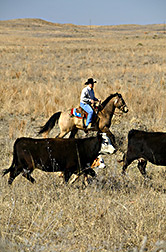Forum—Connecting a Vital Region’s
Agriculture, Ecology, and People
|
|
Its rangeland, pasture, and forage ecosystems make the U.S. Southern Plains vital to the nation’s welfare and economy. The region is in fact a global asset, an important link in the planet’s food chain.
On page 4 of this issue, you’ll find an article focusing on ARS’s Southern Plains Experimental Range. This outdoor laboratory set in northwestern Oklahoma is a main asset in a regional campaign within ARS to strengthen and make the best use of the Southern Plains and other areas like it.
The Southern Plains’ grass prairies are an important livestock-producing area, while its clean air, pure water, and healthy living space benefit an array of plants and animals as well as rural communities. Yet the region has serious problems that must be dealt with in short order.
The land runs of the late 1800s plus governmental programs that over 140 years affected land use have fragmented the landscape spatially, ecologically, and sociologically. These rural areas and their small communities have also been subjected to massive outmigration, which has frayed rural America’s social and economic fabric.
The study of how social, economic, and ecological factors interact within rural ecosystems is an emerging science. But we’ve learned that fragmentation undermines biological complexity, biodiversity, and socioeconomic interaction. Our challenge is to develop agricultural production systems that ease fragmentation’s impact, improve the environment, benefit agricultural producers, and reinvigorate rural communities.
This challenge can be met through a holistic ecosystem approach, buoyed by ARS scientists’ broad expertise in animal nutrition; soil science; plant ecology, physiology, and genetics; and system sciences.
Such an approach would entail several major research approaches, one of which is determining inheritance of valuable traits of key grass species. This would help us improve native warm- and cool-season forages’ tolerance to drought, temperature extremes, and grazing pressures.
Secondly, we need to develop sustainable rangeland and agricultural ecosystem technologies, as well as landscape-management strategies, that decrease resource fragmentation, sustain soils, conserve plant communities, and benefit rural America.
Thirdly, we must address the need for sustainable, integrated stocker and cow-calf production systems that improve forage growth and nutrient quality and extend seasonal forage yields for animal production systems in a variety of soils and environmental conditions.
Lastly, we should establish stronger links between rangeland, pasture, and wildlife habitat management and the economic vitality of family farms, ranches, and rural neighborhoods.
All this must be applied within the structure of ARS’s national programs devoted to development and transfer of technologies and to integrated management strategies that are based on knowledge of ecological processes and that conserve and enhance the nation’s diverse natural resources of rangeland, pasture, and forages.
Together, these national programs encompass a broader approach to managing these ecosystems that requires a better understanding of how climate, soils, organisms, and disturbances influence vegetative structure and flows of energy and materials between living and nonliving components.
Accomplishing all this will result in greater biodiversity of native grasslands, more robust and efficient grazing programs, enhanced wildlife habitat, and increased recreational potential that will create more income opportunities.
These benefits will come about more quickly as ARS scientists at different locations work in concert to extend results across a wider range of soils and climates. Together, these research groups will form a “virtual laboratory”—one without specific boundaries—to evaluate rangeland, pasture, and forage systems that will ease resource fragmentation to the benefit of rural communities.
We need to push the scope of our work beyond the producer level to encompass the needs of the communities that are not only home to those producers, but are also the foundation and fabric of rural America.
Recovery of the Southern Plains ecosystems’ original complexity and natural biodiversity requires viable partnerships with the people who live there. The time has come to take initiative to ensure that this natural resource base will always function at its best, maintaining its natural beauty and vibrant rural communities.
Phillip L. Sims
Research Leader
ARS Southern Plains Range Research Station
Woodward, Oklahoma
"Forum" was published in the June 2005 issue of Agricultural Research magazine.







